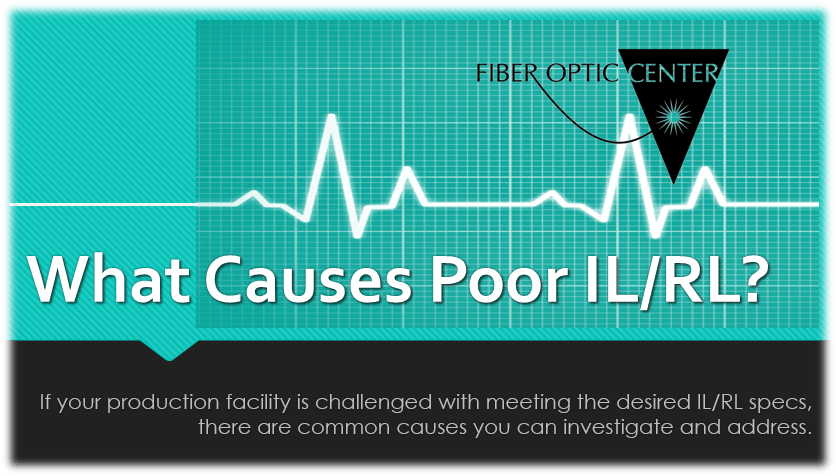Authors: Chris Rollinson and Dan Rocheleau
Most likely, your testing specifications present minimum requirements for a Low IL and High RL.
If your production facility is challenged with meeting the desired IL/RL specs, there are common causes you can investigate and address.<
However, before addressing common causes of poor IL/RL, let’s quickly explain the terms:
- Insertion Loss (IL) – The loss of signal power resulting from inserting a device in an optical fiber. This can be referred to as attenuation and is usually expressed as a ratio, in dB, relative to the input power.
- Return Loss (also called Back Reflection) – The reflection of signal power, usually resulting from inserting a device (such as a connector or other component) in an optical fiber path. Again, this is usually expressed as a ratio, in dB, relative to the input power.

The goal: Connectors are aligned and contacted optimally
The ideal (minimum-loss) fiber path would have NO connections. Instead, it would be one continuous, straight-through glass fiber from Point A to Point B – with no interruptions. Since fiber networks usually require connectors for modularity, path splits, etc., we need a connection with perfectly aligned, intimate “glass to glass” contact that emulates the continuous fiber and gives us the desired Low IL and High RL.
When this perfectly aligned, intimate “glass to glass” contact is not achieved, reduced IL/RL performance is the result. Briefly, here are some common causes.
- End-face quality and cleanliness
At the risk of stating the obvious, fiber end-face defects (scratches, pits, cracks) and particle contamination have a direct impact on the performance of the connector, which contributes to poor IL/RL. Any irregularity that impedes light transmission from one fiber to the other will negatively affect IL and RL. If the fiber, anywhere within the assembly, is bent or pinched beyond its “minimum bend radius,” significant increase in IL will result.
Many of our customers report that contamination on the end-face is the #1 end-user complaint. Thankfully, contamination can be identified and controlled in the production environment. You may want to investigate the process your technicians follow to ensure end-faces are clean, and then shore up training as necessary.
- Misalignment between the 2 cores
In simple terms, the primary purpose of the connector is to hold the fibers precisely, ensuring the core of one fiber abuts neatly and accurately with the core of the other fiber. The goal is for every connector to be able to mate with another connector with precise core alignment and core-to-core contact.
When you encounter poor IL/RL, check these common alignment issues:
- Contamination on the outside of the ferrule or inside the adapter sleeve – For example, epoxy on the technician’s finger transfers to the outside of the ferrule during in-process product handling. This accidental contamination may result in a fiber that is not centered perfectly within the adapter sleeve and, therefore, not aligned. Such process issues can be remedied by improved process controls. Also, the adapter sleeves within adapters can become contaminated and/or damaged after use. Always have new adapters available to try when troubleshooting IL/RL problems.
- The hole in the ferrule is not perfectly centered – This physical characteristic of the ferrule will cause an alignment issue: if the ferrule hole is not perfectly centered, the fiber it holds will obviously never be perfectly centered. If you are using ferrules with poorly centered holes, consider purchasing ferrules with more exacting tolerances. Measuring hole centricity, however, usually requires specialized equipment not commonly used in standard production lines, so you may need to trust the ferrule supplier’s data and shop for the best tolerances.
- The diameter of the ferrule’s hole bore is larger than the outside diameter of the fiber – The ferrule hole bore must be slightly larger in diameter than the fiber to allow the fiber to be inserted into the hole. The smaller the ferrule hole diameter, the more precisely the fiber will be centered in the ferrule (thus, lower Insertion Loss can be expected). However, smaller/tighter-tolerance ferrules are more expensive, and can be more difficult to insert the fiber into. Conversely, the larger the ferrule hole, the more opportunity for the fiber to not sit perfectly centered within the ferrule; thus higher Insertion Loss can be expected (but such large-bore holes will be very easy to insert a fiber into). Knowing the hole specifications for the ferrules you are using is critical to achieve desired IL results. If you are targeting minimum Insertion Loss, you should use the tightest-tolerance ferrule hole diameter available. If you can see a clearly defined “epoxy ring” around the fiber OD when viewing after polishing (usually seen as a thin “crescent-moon” around the fiber), this is the result of the fiber sitting off-center within an oversized ferrule hole. When using a terminated 125um fiber, a 126.0um +/- .5um should be the largest ferrule hole used for most low-loss applications. If your ferrule hole specification is larger than this and you are facing IL performance problems, consider purchasing ferrules with more exacting tolerances.
- Poor core-to-core contact
Optimum core-to-core contact is a must to achieve the desired Low IL and High RL. In fact, that’s a primary purpose of the various industry-standardized geometry specifications. In your testing, when you have good geometry specifications for radius, fiber height and apex, you should have good core-to-core contact. (This applies to both single-fiber connectors and multi-fiber connectors, although multi-fiber connectors have additional geometry parameters to worry about, such as fiber height differences between the fibers, co-planarity, etc.).
If you have poor IL/RL, investigate whether the ferrule end-face geometries are meeting common industry specifications. It is recommended that any high-quality cable assembly production includes 100% verification that polished ferrules meet these geometry specifications.
Do you have a specific issue regarding meeting your desired IL/RL specs?
We’re here to help! Send us your question, and we’ll do our best to provide guidance. FOC is committed to helping you manufacture the best fiber optic cable assemblies possible.
FOC is a resource for questions on this and all technical subjects. AskFOC can be found at: https://focenter.com/askfoc/ where our technical experts answer your questions.




